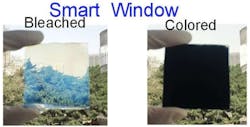My dad got his first pair of PhotoGray eyeglasses in the 1960s and, as a youngster, I was amazed by the “new” technology that allowed the lenses to darken when exposed to sunlight. Of course, it wasn’t really new. Reversible photochromic effects had been observed and recorded by German chemist Dr. Willi Marckwald as far back as 1899.
When used in eyeglasses, photochromic glass lenses employ embedded microcrystalline silver halides to darken in the presence of ultraviolet light and return to a clear state in the absence of UV light.
Plastic lenses can also be photochromic by using organic photochromic molecules, and last April, the U.S. Food and Drug Administration approved the first contact lens to incorporate a photochromic additive that automatically darkens the lens when exposed to bright light. Today, there are many products in addition to optical lenses that incorporate photochromic properties. These materials, like photochromic eyeglass lenses, change their tint with changes in UV light intensity, and return to their original color (or clear) in the absence of UV light. For example, Del Sol sells all kinds of color-changing clothing and accessories in their mostly resort location stores, as well as online. These include sunglasses (the frames change color, not the lenses); nail polish; tee shirts; hats; tote bags; beach towels; skateboards; and key chains. (The tees and nail polish have been big hits with our young granddaughters!)
Commercial applications for photochromic ink include labels on soft drink and beer cans and bottles; branded coffee mugs; fast food packaging; snack bags; security marking; data storage; and window film.
Now researchers at China’s Northeastern University and Nanjing University have developed a photochromic window film that controls UV transmittance and uses solar heat gain to warm building interiors. Because the glass is constructed of materials having some antimicrobial properties and becomes heated when exposed to sunlight, bacteria such a E. coli cannot live on the glass surface, thereby creating a “sterile” window. The film employs gold nanostructures embedded in 3-D tungsten carbide. The 3-D tungsten carbide controls the visible light and the gold nanoparticles and nanorods convert the thermal energy. The window can change from fully transparent to black, and the surface temperature can increase as much as 75°F, in a matter of minutes.
According to one of the principal researchers, Xing-Hua Xia, a “Photothermal Sterile Window” would be ideal for hospitals, buildings in cold climates with abundant sunlight, and high-altitude aircraft. With all the buzz about colonizing the moon, perhaps NASA, the nascent "Space Force", and Jeff Bezos should be taking a hard look at these windows…
A regular contributor to HPAC Engineering and a member of its editorial advisory board, the author is a principal at Sustainable Performance Solutions LLC, a south Florida-based engineering firm focusing on energy and sustainability.










